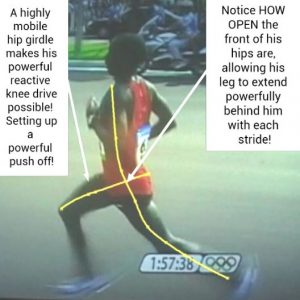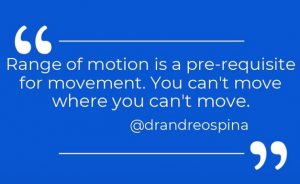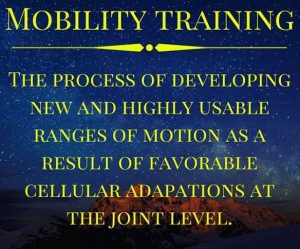Restore: the hips program
mobility
You Can’t Move Where You Can’t Move…
I’ve got some important information to share with you about this program and how YOU can be successful with it – and YOU CAN!
But first, I’d like to discuss one of the very important reasons WHY you are here.
Can we talk running for a minute? Fast running? Injury-free running?
FACT: In order to run at high speeds safely with a low risk of injury, you need to be healthy, stable, and have very good mobility, especially in the hips.
What do I mean?
Having a large available range of motion in the hip joints helps to resist impact forces AND allows you to stride longer and easier.
Put simply, you can’t run safely and efficiently at a fast speed without a good range of motion in your hips.

Notice how much flexion and extension of the hips this marathoner is able to achieve!
Think About It:
When you see a very fast efficient-looking runner, they appear to be covering a significant amount of ground with every stride.
There are a few reasons why that happens, but know… that it WON’T happen unless the hip joints can move freely, allowing the knees to drive forward during the swing phase of the stride, and the legs to push back powerfully.
Check out the image to the left as one example – that’s 2008 Olympic Marathon champion, Sami Wanjiru. What you see during this “mid-flight” stage of the gait cycle is an obviously large range of motion at the hips.
This brings me to this: You can’t move where you can’t move.
Want to see more? Then CLICK HERE to watch Sami run!
Be sure to hit the back button so you can continue reading!
WHAT IS MORE IMPORTANT?
The patterns we develop while we train OR… the “tools” we use to create those patterns?
When you do any of the things I mentioned above (or anything else movement-related), from a broader perspective, you are essentially doing both of these things:
1. You’re demonstrating your skill in that movement, your level of coordination – you are demonstrating a pattern. This is learned and with practice, will improve – to a point.
2. You’re also demonstrating the present capacity of the joints that are involved in that skill or pattern, to move. It’s this #2 that I am focusing on right now. Keep reading!
Think of it this way: the pattern or skill is the task – the “job” you want to accomplish.
The ability of the joint(s) in question to move (or your ability to control that movement), is the tool to accomplish the job.
So, I’ll say it again: You can’t move where you can’t move.
Crappy Tools = Crappy Building.

Think about it. THIS, is why you are here!
If I am a carpenter and I’ve gathered some lumber to construct a building, I need a variety of tools to do it (a hammer, saws, etc.).
If my hammer or saw doesn’t work, my ability to use that lumber to put together the building I want is going to be severely limited. I’m essentially trying to be a carpenter with crappy tools. A carpenter needs good tools to be able to build a high-quality building.
Tools = Joints. Patterns = Fitness.
To put it another way, if you’re attempting to build a great skill or pattern or build “fitness,” but have crappy “tools” to do it with, you’re going to be bumping up against a limitation that will stop you dead in your tracks and limit how far you can go, or how much you can improve.
To PRINT a PDF of all of the written information on this page, CLICK HERE!
How many times have you watched a youtube video of a great runner and wondered how you might also run like that? (Especially as we get older!). What you’re seeing is THAT runner’s ability to move and to control that movement. You’re seeing a combination of skill (pattern) and that person’s joint capacity to move.
I am sometimes critical of “teaching” videos on youtube that don’t teach. Instead, they often show young, highly-skilled, very fast runners demonstrating cool running drills, cool bounding, etc. What they are doing is demonstrating HOW THOSE runners CAN move. They are NOT showing us how WE CAN improve how WE move. You can’t move where you can’t move.
To Summarize:
 Fitness is only part of the total equation. Sure, to become better, faster, stronger – to accomplish whatever goals you have for yourself, you definitely need to train. And train hard. Relentlessly.
Fitness is only part of the total equation. Sure, to become better, faster, stronger – to accomplish whatever goals you have for yourself, you definitely need to train. And train hard. Relentlessly.
But…. fitness is only part of it. And it IS the part that most athletes focus on.
And honestly, it’s the easy part. Doing the training, like constructing a building, is a LOT easier when you have great “tools.” All you need is a desire to get out there and work at it.
Want to get better? Train harder.
Want to go longer? Do more miles.
Want to get faster? Do more miles and do them harder.
And it IS the part – the swim/bike/run training, that gives us the greatest feeling of accomplishment and enjoyment. I get it!
What I’m hoping to convey to you as you embark on this program is this: getting this enjoyment and satisfaction requires you do the other things – look at some other factors – that allow you to train with a low risk of injury and a high potential for speed. I often say about myself, “It’s the price I pay, to play.”
Being able to train how you want to = fun.
Injury = the opposite of fun – despair, frustration.
Ok, on to the next page which is: Our Mobility Training: A Primer
